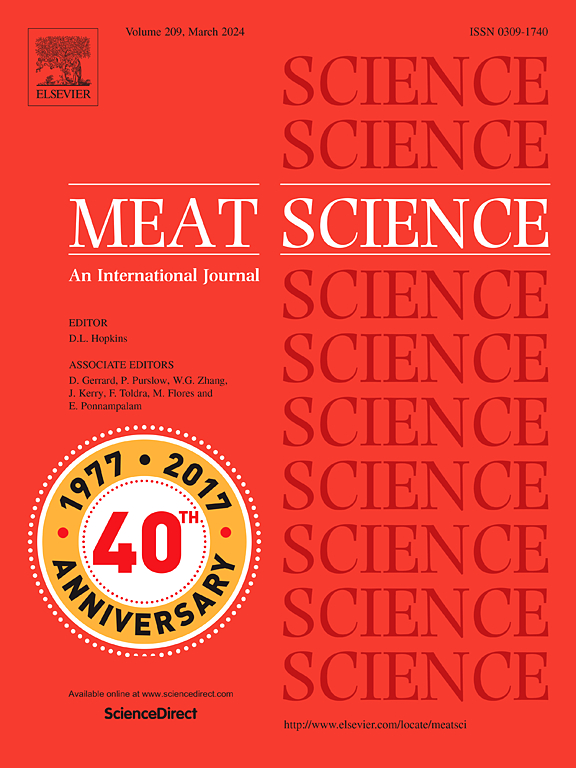Non-destructive spectroscopy-based technologies for meat and meat product discrimination - A review
IF 6.1
1区 农林科学
Q1 Agricultural and Biological Sciences
引用次数: 0
Abstract
Consumers' confidence in products of animal origin is highly subjected to the quality guarantees offered by the manufacturing and retail industries. Traditionally, meat quality evaluation has been conducted through destructive, time-consuming and chemical-dependent protocols. Smart methodologies based on the non-destructiveness and/or non-contact with the samples, such as spectroscopy-based technologies, arise as an alternative promising tool. This comprehensive overview includes literature published in the last decade applying spectroscopy-based techniques in the Visible (Vis) and near-infrared (NIR) regions of the spectrum (Vis-NIR), either individually or combined with imaging (hyperspectral imaging, HSI), to classify meat and meat products based on ante- or postmortem factors. First, a brief introduction to the fundamentals of Vis-NIRS and HSI is included. Secondly, the main applications of Vis-NIRS and HSI technologies for meat qualitative purposes only are discussed. The Vis-NIRS and HSI have been successfully used in lab scale studies (> 90 % overall accuracy) to discriminate meat and meat products according to antemortem (feeding system, species, origin and breed) and postmortem (freshness, meat quality, label claims) factors. Recently, spectral data collected with handheld Vis-NIR equipment have become more frequent, although the use of portable HSI has not been widely explored. From the studies reviewed, the main concern regarding spectral data is to shorten modelling handling times, including strategies to both extract optimal wavelengths from NIR and compress spectral data from HSI. Despite the efforts made to overcome instrumentation and data processing challenges, a gap remains to be covered up to a real-time implementation in industrial line quality control.
基于无损光谱的肉类及肉制品鉴别技术综述
消费者对动物源性产品的信心很大程度上取决于制造业和零售业提供的质量保证。传统上,肉质评估是通过破坏性的、耗时的和依赖化学物质的方法进行的。基于非破坏性和/或不与样品接触的智能方法,如基于光谱的技术,作为一种有前途的替代工具而出现。这篇全面的综述包括过去十年发表的文献,这些文献应用光谱技术在光谱(Vis-NIR)的可见光(Vis)和近红外(NIR)区域,单独或结合成像(高光谱成像,HSI),根据死前或死后因素对肉类和肉制品进行分类。首先,对Vis-NIRS和HSI的基本原理进行了简要介绍。其次,讨论了Vis-NIRS和HSI技术仅用于肉类定性目的的主要应用。Vis-NIRS和HSI已成功用于实验室规模的研究(>;根据死前(饲养系统、物种、来源和品种)和死后(新鲜度、肉质、标签声明)因素来区分肉类和肉制品。最近,使用手持可见光-近红外设备收集的光谱数据变得越来越频繁,尽管便携式HSI的使用尚未得到广泛探索。从所回顾的研究来看,对光谱数据的主要关注是缩短建模处理时间,包括从近红外提取最佳波长和从HSI压缩光谱数据的策略。尽管已经努力克服了仪器仪表和数据处理方面的挑战,但在工业生产线质量控制的实时实施方面仍然存在差距。
本文章由计算机程序翻译,如有差异,请以英文原文为准。
求助全文
约1分钟内获得全文
求助全文
来源期刊

Meat Science
工程技术-食品科技
CiteScore
12.60
自引率
9.90%
发文量
282
审稿时长
60 days
期刊介绍:
The aim of Meat Science is to serve as a suitable platform for the dissemination of interdisciplinary and international knowledge on all factors influencing the properties of meat. While the journal primarily focuses on the flesh of mammals, contributions related to poultry will be considered if they enhance the overall understanding of the relationship between muscle nature and meat quality post mortem. Additionally, papers on large birds (e.g., emus, ostriches) as well as wild-captured mammals and crocodiles will be welcomed.
 求助内容:
求助内容: 应助结果提醒方式:
应助结果提醒方式:


